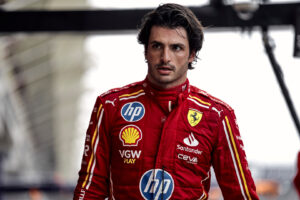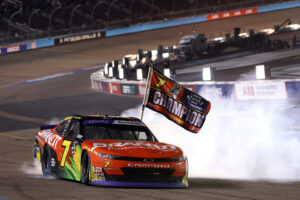With the Constructors’ Championship in Red Bull’s bag and Max Verstappen’s possibility to become a three-time World Champion in the Sprint race, this weekend started off as very promising. Let’s see how the strategies made a difference at the Qatar Grand Prix.
The Qatar Grand Prix entered the Formula 1 calendar for the first time in 2021. This year the Lusail International Circuit hosted the second ever Qatar Grand Prix. In addition, Lusail held the fourth of the six Sprint races of the 2023 calendar. Furthermore, this race week has seen an unprecedented tyre drama complete with a big strategy problem. As for the weather, it’s always a critical factor in the strategy used by each team. During the race, however, the high temperatures combined with the already extreme conditions strained the drivers’ health. Let’s see how the teams navigated this particular race weekend.
The key elements of the Qatar Grand Prix
Before Sunday’s race, there were three key elements to take into consideration. Environmental conditions, tyre degradation levels, and track layout were all fundamental elements that influenced the race.
The environmental conditions were fundamental in relation to the race. There were 31 degrees throughout the race which made the temperatures extremely hot, especially for a night race. Though we’ve seen much hotter temperatures in this season. What made the conditions harder than usual was the extreme humidity. Humidity was over 75% and there wasn’t any natural ventilation either. So this is where the first difficulties came in.
The layout of the track was another aggravating reason for the problems in the cockpit. The sheer g-force loads that go through the body can also strain the drivers. Lusail has a brutal layout with its long, loaded corners. Turns 12-14 needed revising on Friday night because they were putting too much stress through the rubber. That means that it was also putting a huge effort through the drivers in the cars. Lusail is ranked as the hardest circuit on the calendar for tyre stress.
The icing on the cake came with the introduction of a mandatory three-stop race. As said before, no one was allowed to run a tire beyond 18 laps as a precaution. This meant that the drivers could push flat-out for each stint. With this, the race was broken down into four quarters of qualifying lap sessions. We also discovered that the medium rubber could last the 18-lap distance without degrading while the hard got quicker the more the drivers were pressing on. In the end, the 18-lap limit proved to be the right solution to the curb-induced problems identified by Pirelli.
Strategy: What Pirelli said and tyre drama
The Lusail International Circuit is a fast and flowing track where medium and high-speed corners predominate. The only DRS zone overlaps with the main straight of over one kilometer of the total length of the track. The hot temperatures also make it very interesting to drive.
For the Qatar Grand Prix Pirelli nominated the C1 (hard tyre), C2 (medium tyre), and C3 (soft tyres), just like in Japan. This can give us some info on the type of race that Pirelli expected this to be. In addition, due to the revised Sprint format, there was a change in the number of sets of rubber given to the teams. Two sets of hards, four mediums, and just six of the softs. Pirelli also increased the number of the medium compound because of the Sprint race. It’s required of the teams to use the medium compound in the first two rounds of the Sprint’s qualifying sessions.
Following the only Free Practice session of the weekend Pirelli discovered a tyre wear issue. The analysis revealed “a separation in the sidewall between the topping compound and the carcass cords on many of tyres that were checked”. The FIA and Pirelli believed that a significant number of additional laps could have caused the damage to the tyres with a subsequential air loss. The plan was to analyze the tyres used in the Sprint to decide how long the teams could run the rubber on Sunday’s race. The conclusion was that 18 laps was the maximum number per new set. On Saturday, the FIA decided to also revisit track limits at turns 12 and 13.
Sprint race madness
The Mercedes of Russel and the Ferraris of Carlos Sainz and Charles Leclerc opted to start the race on the more aggressive softs. In front of them, both McLaren’s and Max Verstappen started on the mediums. The tyre choice was split across the rest of the grid. With the Aston Martins, the Alpines, and Logan Sargeant opting to use the soft tyres leaving the remaining drivers on the medium rubber.
Pole-sitter Oscar Piastri lost the lead to George Russell early on amid opposite tyre strategies. While the soft tyres proved to be the right choice for the first stint, the mediums came in handy for the later part of the race. Piastri kept the lead of the race after a clean takeaway. Instead, Norris and Verstappen lost positions to the trio using softs just behind them.
Embed from Getty Images
Restart Drama
After two Safety Cars, those on softs gained an advantage in extracting more life out of the rubber. Nearly halfway through the race, things changed. Verstappen, in fifth place, turned up his pace to close in on Leclerc, who was in front of him. Ducking into the Ferrari’s slipstream he successfully overtook Leclerc before repeating the same trick on Sainz. Piastri slashed the gap between him and Russell, taking the first place. In the meantime, Norris made a pass on Leclerc for P6. Then, another Safety Car was needed after a failed attempt to make a double overtake on Hulkenberg by Perez and Ocon.
At the end of Lap 14, the race resumed once more. Russell’s soft tyres were done and this facilitated the overtaking of him by Norris and Verstappen. Then, Piastri crossed the line taking his first career win in F1 with Verstappen and Norris just behind him. With this second place, Verstappen was able to take home his third world title.
A race to forget
The majority of the field started the race with medium tyres with a handful of drivers on mediums and Perez on hards. For the Qatar Grand Prix, however, tyre management wasn’t required because of the artificial limit of 18 laps per set imposed by the FIA. This permitted the drivers to go flat-out. However, this only increased the stress upon the drivers in the intense heat. Moments after the lights went out in Lusail, Hamilton and Russel went wheel-to-wheel making contact. Hamilton was out of the race while Russell pitted for a new front wing at the end of the opening lap. Instead, Verstappen continued his title celebrations with another fantastic win. The McLaren’s backed up an impressive Sprint race taking home another double podium, their third in a row.
During the race, we saw other impressive performances that were overshadowed by the worrying physical conditions of the drivers. Sargeant, for example, was forced to end his race prematurely due to the overwhelming physical strain. Unfortunately, he wasn’t the only one who reported the enormous physical stress. In fact, half of the grid went to the medical center after the race. Ocon threw up two times during the race, Norris and Russell opened their visors and took their hands off the steering wheel to try to refresh.
The drivers’ health is the number one priority, which was put in jeopardy in this race. Formula 1 has always been an extreme sport for the conditions the drivers have to endure, but this race has crossed the limit. Hopefully, this will serve as a lesson to the FIA to improve the way these extreme conditions are handled.






